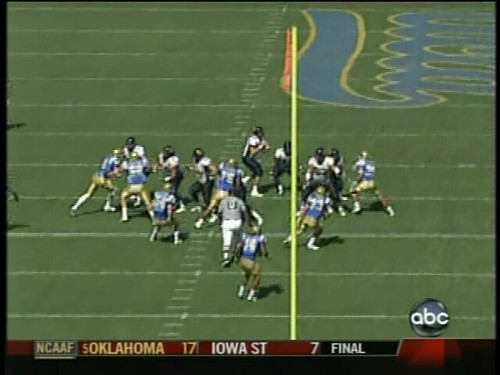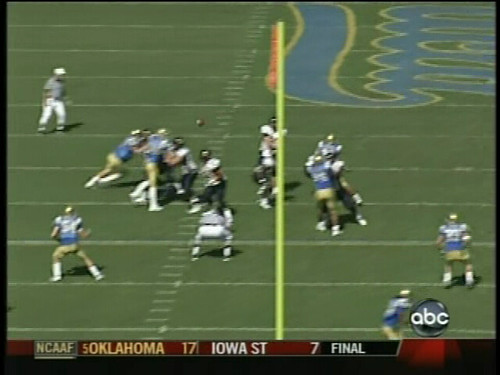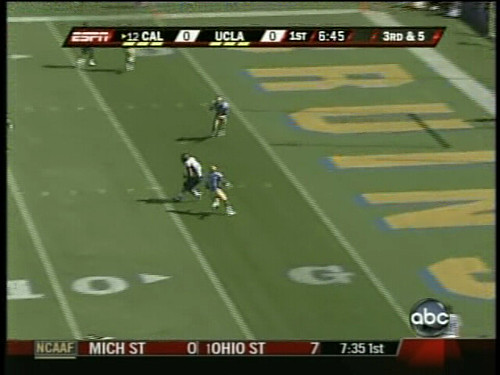Breaking Down the Cover Two (Cal at UCLA, 2007)
UCLA has one of the most feared defenses in the Pac-10. Their defense is not only very talented, their coordinator DeWayne Walker is one of the best in the biz. He mixes packages, his corners play great on the edges, his run defense stuffs everyone on 1st down. So the only ways for an offensive coordinator to beat his teams require at least a few of these criteria to be filled:
(1) Be completely stacked with talent.
(2) Be smart with your playcalling.
(3) Force turnovers and do something with them.
Cal accomplished only one and a half of the three criteria in their Rose Bowl matchup last fall. The turnovers they took from UCLA led to other turnovers or resulted in nothing.
However, there were some very smart playcalls this past spring, and it’s time to take a look at how Tedford took advantage of UCLA’s defense early in the game. This first article will examine his knocking of the Cover Two on Cal’s first drive.
The cover two definition goes as follows:
By far the most complicated zone coverage with the safeties playing deep and covering half the field each. In cover two the cornerbacks are considered to be “hard” corners, meaning that they have increased run stopping responsibilities and generally defend against shorter passes, although if two receivers run a deep route on a certain side of the field, that side’s corner has deep coverage responsibility as well. It also relies heavily on the Mike (Middle) Linebacker’s ability to quickly drop deep downfield into pass coverage when he reads pass.
In essence, cover defense is something that’s meant to confuse receiver patterns as well as break down the offenders.

Here we have a 3rd and five situation at UCLA’s 21, two wide receivers lined out to the left. UCLA is lined up in the 4-3, but the package is a Cover 2. One corner (top right) seems to be exclusively playing Jackson at the top (already three catches for 24 yards). The other corner (far bottom right) is eyeing a run play with Forsett at the bottom but also keeps an eye on Craig Stevens, because he’s not well equipped in single coverage to take down a tight end. Nevertheless, that’s his responsibility if it is the pass.

Now the key role is filled in by the middle linebacker (#14), which you can see in this shot. If Cal is expecting pass, the inside linebacker will have to adjust to pass. If they’re running, he’s the last person standing between Forsett and a fifteen yard gain. So it’s up to him to decide where to go on the field, and his decision directly influences the outcome of the play.

Well the middle linebacker is reading the pass, and now he consciously makes the effort to turn for the sprinting receivers on the right side. This is probably a no-win for the middle linebacker. His best idea would have probably been to back up vertically, but instead he commits to one area of the field.

Unfortunately for him, Longshore’s not looking for his wideouts. He’s turning his body in the other direction.

The key to the Cover Two is finding the holes in the defense (just like in any zone), and that’s contingent on the quarterback knowing where the middle linebacker is going. If the linebacker’s going right, then who might have single coverage on his left.

The barreling Craig Stevens, that’s who. Mismatch on the corner, 7-0 Cal!

So, it appears one of two things is possible: (1) Longshore has the ability to adjust on the fly and avoid the bad play, (2) Tedford knew exactly where to make that play go on a 3rd down situation, considering UCLA’s prowess on that down (passing defense holds the efficiency rating of opposing QBs to 83.94). I’m leaning toward the latter, because good coaching is more evident at the beginning of a game. With Longshore throwing to Jackson early, the defense seemed to be honing in on DeSean on pass plays. That left secondary receivers open, allowing for Stevens to get single coverage. I’m sure Nate had the ability to adjust on the fly, but this was Tedford exploiting the defense.
It was an advantage he exploited early. Yet he would go back to Jackson down the stretch, and he would not be as fortunate.
More on the Cover Two here and here.
- None Found
Comments (7)
 Logging you in...
Logging you in... (1) Indeed, UCLA appears to be playing a cover 2. But they have shifted their LBs over towards the twin WRs (visible in the first picture). The two LBs in the second picture are the MLB (between the Cal LG & LT) and the SLB (between the C and RG).
(2) UCLA player #14 is actually SS Chris Horton.
http://uclabruins.cstv.com/sports/m-footbl/mtt/ho...
I suppose it appears as if he's the MLB since he's between the other two LBs and he's somewhat in the box (playing about 9 yards off the LOS).
(3) UCLA does play a lot of Cover 2, and the TV guy even notes that after the touchdown. He says that the way to beat the Cover 2 is to go right down the middle (splitting the safeties). He's right, but that's not what happened in this case. In this case the touchdown is a product of (i) a QB half roll left; (ii) in conjunction with all the receiver routes going left; and (iii) Longshore moving the safeties with his eyes. Watching the play on DVR, it's a more obvious (than from the pictures) that Longshore looks off the safeties (primarily #14) by purposely staring down the WRs on his half roll. This causes #14 to turn his body towards the WRs, step towards the WRs, commit to them, and thus turn his back to Stevens on a seam route behind him. The UCLA CB isn't playing Stevens that tight probably because he thought he had safety help. Indeed he should have but #14 UCLA SS Horton bites on Longshore's veteran moving-the-safeties skill.
What this play shows me, more than anything else, is balance. There's balance in terms of run-vs.-pass; either was a legitimate option in this situation, which kept the defense guessing. And there's balance in the formation, with the Tight End providing an option on the short side of the field, while the backs and receivers are stacked to the wider left side. What I especially like is the pass protection that this formation affords. Stevens was able to release right from the snap, with the O-line covering his absence by going to UCLA's left. This worked because not one, but two, running backs were able to shut down (with the Left Tackle) UCLA's right-side pass rush.
Great play call, great execution. Too bad it didn't last for four quarters.
Good stuff, Avinash.
Yeah you're right, #14 is the safety here. I think his assignment might have been to cover a particular area, and his decision was to go and check the slot receiver rather than play back. However, that made it tough for the corner to check Stevens on his own.
California Pete,
Cal's first quarter offense was without parallel. I think the Bears led or were tied in every one of their first quarters until the Washington/Stanford debacles. Longshore was throwing effectively and Forsett was always a capable runner. It's just later on when the team started falling behind that things went south.
Can't really argue with anything you've said. Principles were similar though in both situations. Longshore's switch in motion keyed the defender toward one area of the field.
Comments by IntenseDebate



 Loading IntenseDebate Comments...
Loading IntenseDebate Comments...
Comments are closed.